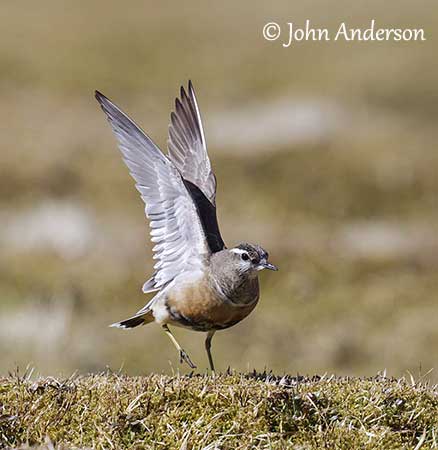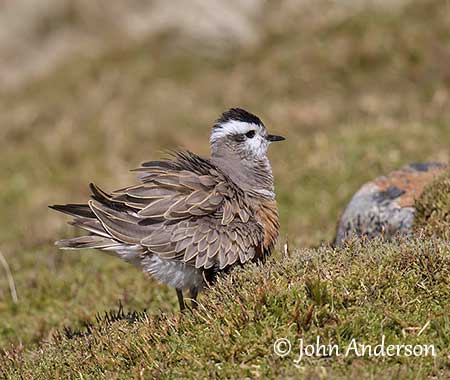
Fr: Pluvier guignard
Ang: Eurasian Dotterel
All: Mornellregenpfeifer
Esp: Chorlito Carambolo
Ita: Piviere tortolino
Nd: Morinelplevier
Sd: fjällpipare
Photographers:
John Anderson
John Anderson Photo Galleries
Otto Plantema
Trips around the world
Ingo Waschkies
Bird Photography
Text by Nicole Bouglouan
Sources:
HANDBOOK OF THE BIRDS OF THE WORLD Vol 3 by Josep del Hoyo-Andrew Elliott-Jordi Sargatal - Lynx Edicions - ISBN : 8487334202
SHOREBIRDS by Peter Hayman, John Marchant and Tony Prater – Christopher Helm – 1986 – ISBN: 0747014035
THE HANDBOOK OF BIRD IDENTIFICATION FOR EUROPE AND THE WESTERN PALEARCTIC by Mark Beaman, Steve Madge - C. Helm - ISBN: 0713639601
GUIDE DES LIMICOLES de D. Taylor - Delachaux et Niestlé - ISBN : 2603014080
THE COMPLETE BOOK OF BRITISH BIRDS – Written by “Royal Society for the Protection of Birds” experts - Préface de Magnus Magnusson - Michael Cady- Rob Hume Editors - ISBN: 0749509112
ENCYCLOPEDIE DES OISEAUX DE FRANCE ET D’EUROPE – de Peter Hayman et Rob Hume - Flammarion – ISBN : 2082009920
L’ENCYCLOPEDIE MONDIALE DES OISEAUX - Dr Christopher M. Perrins - BORDAS - ISBN: 2040185607
What Bird-The ultimate Bird Guide (Mitchell Waite)
Wikipedia, the free encyclopaedia
Birdwords - The official site of Dominic Couzens, natural history writer
Identifying Eurasian Dotterel on migration
Breeding chronology and mating system of the Eurasian Dotterel
Eurasian Dotterel
Charadrius morinellus
Charadriiformes Order – Charadriidae Family
INTRODUCTION:
The Eurasian Dotterel is a beautiful, small plover. The female has brighter plumage than male, and she does not take part in nesting duties. The male incubates the eggs and tends the chicks, while the female mates with several different males.
This species breeds in the northernmost regions of Europe, from N Britain to Chukotsky Peninsula in extreme E Siberia, and in Caucasus and NW Alaska. It moves S to spend the winter in N Africa and Middle East.
It breeds in Arctic tundra. During winter, it frequents steppes, farmland and semi-desert, and may occur at high elevation.
The Eurasian Dotterel is threatened by climate change as boreal landbird. The population is decreasing, but the species is not currently globally threatened.

DESCRIPTION OF THE BIRD:
Biometrics:
Length: 20-22 cm
Wingspan: 57-64 cm
Weight: M: 86-116 g – F: 100-142 g
The Eurasian Dotterel female in breeding plumage has brighter plumage and is slightly larger than male.
She has dark brown forehead with whitish speckles. Crown and nape are dark brown. We can see a long, broad, white supercilium extending from above the eye and meeting in a “V” on the nape. Lores and ear-coverts are blackish, but sides of face, chin and throat are white.
The upperparts are dark greyish with narrow, dull rufous edges, especially on scapulars and tertials. On the upperwing, the outer primary shows clear white shaft visible in flight.
On the uppertail, the central rectrices are dark grey shading to black with narrow cinnamon tips, whereas other rectrices show black subterminal bar and white tip.
On the underparts, neck and upper breast are grey, sometimes finely streaked brownish. The grey upper breast is bordered below by a narrow blackish line, and then there is a neat white breast band bordered below by an irregular dark line. Upper belly and flanks are deep chestnut, while central belly is black. Vent and undertail-coverts are white. On the underwing, coverts and axillaries are dull pale greyish.
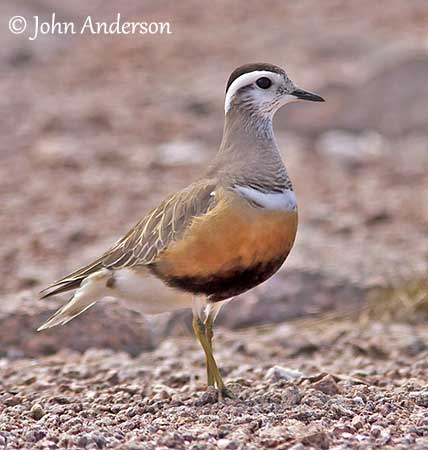
The breeding male shows similar pattern, but its plumage colour is duller. The breast band is less sharp than in female. The crown is slightly streaked and appears paler. The breast is browner and there is less black on belly.
The bill is slim and fairly short. It is usually black with sometimes some greenish or greyish at base of lower mandible. The eyes are dark brown. Legs and feet are dull yellow to yellowish-brown.
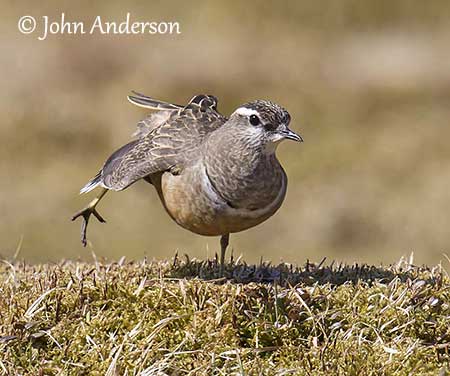
The non-breeding adult is much duller with upperpart feathers fringed buff-brown. The white line is less conspicuous on the pale grey-brown breast. The belly is white. There is no black on the head. The forehead is heavily streaked and the supercilium is mostly brownish-buff instead of white.
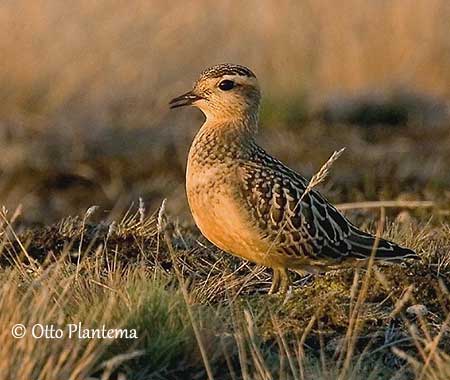
The juvenile resembles adult in winter, but on the upperparts, the feathers are darker brown with brighter buff fringes, sometimes broken by a brown shaft-streak. Neck and breast are pale cinnamon and mottled brown. The underparts are washed buff.
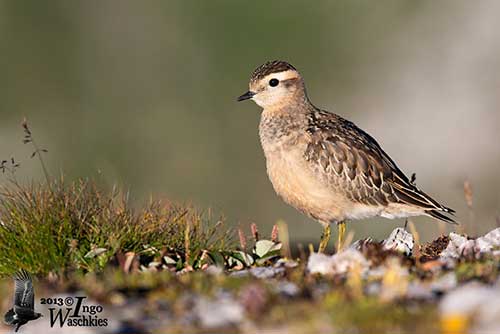
The first winter resembles juvenile, whereas the second year acquires some dark feathers on belly.
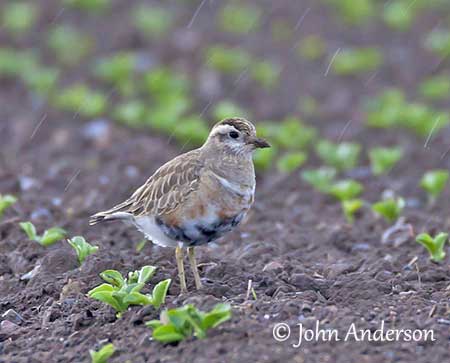
RANGE:
The Eurasian Dotterel breeds in the Arctic tundra of N Eurasia, from N Britain through Scandinavia and N Siberia to Chukotsky Peninsula. Also in NE Kazakhstan and NW China, E through S Siberia, and N Mongolia to SE Russia.
It breeds irregularly in other regions such as Pyrenees, Alps, Carpathians, and elsewhere in Europe, in Caucasus and also in NW Alaska, and once on Spitzbergen.
It winters in N Africa and Middle East to W Iran.
HABITAT:
The Eurasian Dotterel breeds on flat or slightly sloping stony tundra, mountain ridges and plateau with sparse, short vegetation like grass, moss and lichens interspersed with bare rocks. It breeds in Arctic tundra and Arctic-alpine tundra zone and not particularly near water. It has been recorded up to 2720 metres of elevation in Pyrenees.
On passage, it frequents open hilltops and mountain tops with short vegetation, heathland and ploughed fields. It usually returns to the same sites every year.
The wintering grounds are less known, but it frequents semi-desert and dry, stony or shrubby steppes and ploughed farmland. It can be seen up to 1600 metres of elevation in N Africa.
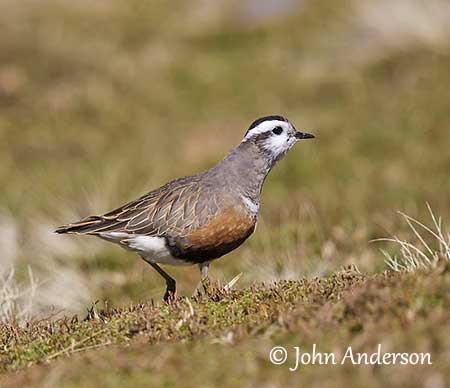
CALLS AND SONGS: SOUNDS BY XENO-CANTO
The Eurasian Dotterel is fairly silent. It gives soft trilling “pyurr” or “keerr” on take-off. During the aerial displays, it utters soft, repeated “pwit-pwit-pwit” also produced at other times. The alarm call is a tinkling “wit-wit-wit-wita-wita-wita-wee”.
BEHAVIOUR IN THE WILD:
The Eurasian Dotterel feeds mainly on insects and small invertebrates including snails, worms and shellfish. Insect diet includes Coleopterans, Dipterans, larvae of butterflies and moths, grasshoppers, crickets, ants and spiders. It also consumes plant material such as leaves, flowers, seeds and berries. The chicks usually consume soft-bodied prey.
It feeds by a run-and-pause technique, but it also uses sometimes foot-trembling on the ground. It feeds both by day and by night.
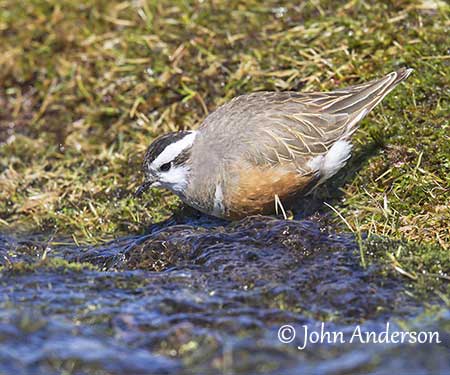
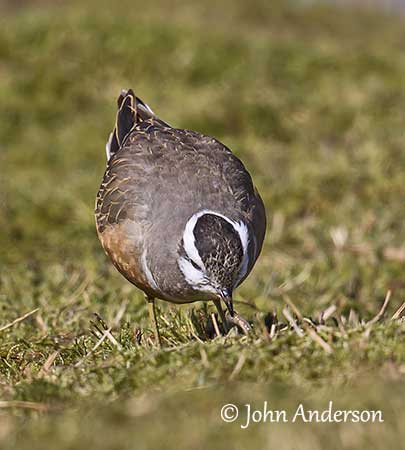
The Eurasian Dotterel practices an unusual mating system in which the sex roles are reversed. The female tends to take the lead in display, and enhances her bright plumage while displaying. After the laying, she rarely incubates the eggs or tends the young. She mates with other males and may produces 2-3 clutches per season.
Once arrived on the breeding grounds, the females form flocks named ‘trips” and gather on a display area, awaiting the male’s arrival. They also perform displays flights and chase each other.
The males first keep their distance and spend their days feeding. Then, the “trips” mix and the females initiate courtship behaviour.
The female moves among males, attempting to isolate one from the rest of the group. She continually raises and folds her wings in a beautiful movement. She also may run away from the male, pretending to be incubating or brooding. If the male is interested, both birds launch into the air and perform a mutual aerial display.
Once paired, the male keeps the female away from other males while she is forming the eggs, in order to protect its paternity.
Once the eggs are laid, the female tries to find another male, but sometimes, she remains monogamous because the females often outnumber the males. She may sometimes share the incubation of the second or third clutches.
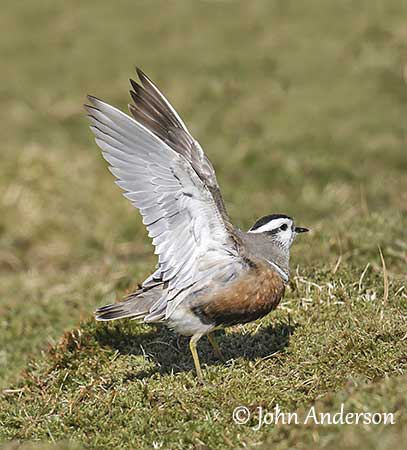
The Eurasian Dotterel is migratory. After the breeding season, the birds move S to reach a narrow area from Morocco to Iran to spend the winter. They winter between September and April, but the return migration usually starts in late February. They migrate in small flocks and use traditional stopovers at usual sites.
The Eurasian Dotterel has strong, swift and direct flight with rapid wingbeats.
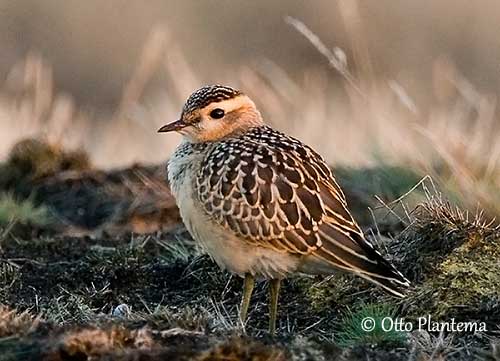
REPRODUCTION OF THIS SPECIES:
The breeding season occurs in spring, with the laying between mid-May and early July, according to the range.
The Eurasian Dotterel is seasonally monogamous, but females are polyandrous and mate with several males and may produce 2-3 clutches per season. They nest solitary, but 2-5 pairs may breed in well-spaced nests in restricted suitable habitat.
The nest is a shallow depression on the ground, lined with leaves, moss and lichens.
The female lays 3 brown-olive eggs with black markings. The male incubates during 21-29 days, while the female produces a second clutch 5-11 days (or more) later, and sometimes a third clutch.
The polygynous male has often 2-3 mates, and two clutches in the same nest are reported. The female may take part in incubation in 2d or 3d clutches.
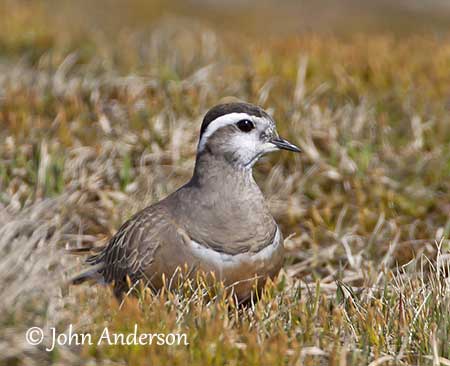
At hatching, the chicks have white down with cinnamon and black markings on head and upperparts. Nape, broad supercilium and underparts are white. They are tended by the male, but the female may sometimes defend the chicks at nest. The young fledge between 19 and 30 days after hatching. They leave the nest and probably migrate with their father, and remain together for some time during winter.
They are vulnerable to predation by mustelids in Scotland, and Common Ravens. Nest failure is often the result of bad weather conditions such as heavy rain or snow.
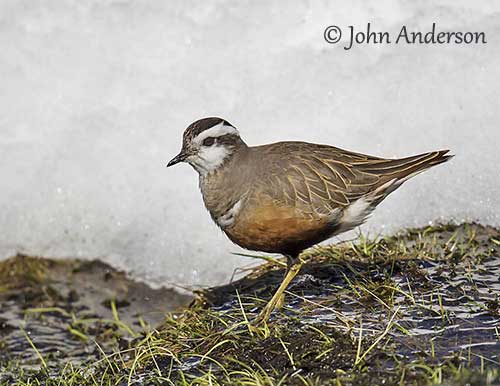
PROTECTION / THREATS / STATUS:
The Eurasian Dotterel is threatened by some degradation of the habitat in Britain, probably due to overgrazing, increasing acidification of soils and recreational uses. Predation at nest may involve nest failures.
The global population is estimated to number 50,000/220,000 individuals (2006). This population is decreasing, but currently, the Eurasian Dotterel is evaluated as least Concern.
